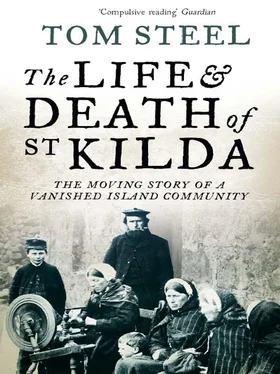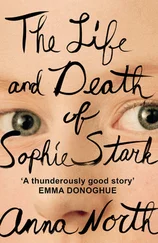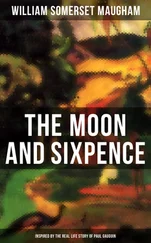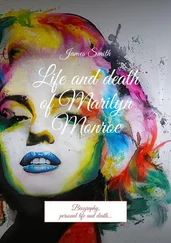The slaughter of sea fowl for food was essential to life on St Kilda. What the reindeer is to the Laplander, so the gannets, fulmars and puffins that each year made their nests on the cliffs of the rocky archipelago were to the St Kildans. Due to the poverty of the soil, other forms of subsistence were incapable, on their own, of maintaining human life on Hirta. The islanders had their sheep, a few cattle, and a meagre crop of potatoes, barley and corn, but without the flesh of the sea birds they could never have survived. Totally cut off from the rest of society, they were only able to live on their island by denying themselves the way of life common to crofters in other parts of Scotland and becoming, as Julian Huxley remarked, ‘bird people’.
‘The air is full of feathered animals,’ wrote John MacCulloch when he visited St Kilda in 1819. ‘The sea is covered with them,’ he continued, ‘the houses are ornamented by them, the ground is speckled with them like a flowery meadow in May. The town is paved with feathers…The inhabitants look as if they had all been tarred and feathered, for their hair is full of feathers and their clothes are covered with feathers…Everything smells of feathers.’
The sea birds and their eggs were jealously guarded by the St Kildans. In 1695, a boatload of strangers attempted to steal some eggs from the cliffs. The St Kildans fought off the intruders and put the precious eggs back in their nests. For good measure the islanders confiscated the pirates’ trousers before sending them on their way. During the nesting season, the single egg laid by the fulmar was not allowed to be removed for eating. Steps were taken to prevent the sheep and dogs from worrying the birds. Every June, the St Kildans fenced off the cliff tops with ropes made from hay with feathers stuck into them, so vital was it to the community that the eggs be allowed to hatch. When Parliament at Westminster passed an Act for the Preservation of Sea Birds in 1869, acknowledgement was made of the islanders’ dependence upon their feathered itinerants. A clause was inserted excluding St Kilda from the provisions of the Act because of ‘the necessities of the inhabitants’.
For nearly nine months of the year, the St Kildans were preoccupied with the killing of sea birds. ‘From their dependency on the capture of sea fowl for their support,’ wrote George Atkinson, ‘all their energies of body and mind are centred in that subject and scarcely any of their regulations extend to anything else; from the period of the arrival of the fowl in the month of March, till their departure in November, it is one continued scene of activity and destruction.’
Puffins in their hundreds of thousands were the first birds to return in March after a winter at sea. Most of them made for the island of Dun, and the St Kildans lost little time in seeking out the first fresh meat they had had the opportunity to taste for nearly four months. The adult gannets would begin to come back at the end of January, but it was not until April that the islanders would launch the boats to go to Stac Lee and Stac an Armin to kill the birds. During the month that followed, gannets and puffins continued to provide the people with food, and the fulmars nesting on the ledges of the cliffs of Conachair offered a welcome change of diet. Although the fulmar eggs were never taken from the nest because the female laid only one, those of the gannet and the guillemot were taken in their thousands. The St Kildans ate them fresh, or preserved for consumption at some later date, in the knowledge that the female of those species would replace the stolen egg.
June and July were lean months as far as sea birds were concerned. The puffin was the only bird available for eating while the young gannets and fulmars hatched and grew. The harvesting of fulmars took place in August when the young birds would be killed in their thousands before they could leave the nest. The young brown-feathered gannets, or gugas as they were called, matured more slowly, and it would be a month later before the men would take to the boats and rob the stacs of the birds.
When Martin Martin visited St Kilda in 1697, he estimated that 180 islanders consumed 16,000 eggs every week and ate 22,600 sea birds. From Stac Lee alone, he reckoned, the St Kildans took between five and seven thousand gannets annually. A century later an observer calculated that nearly 20,000 gannets were harvested each year on Stac Lee and Stac an Armin. In 1786, over 1,200 gugas were taken from their nests in a single expedition.
In the nineteenth century, however, the number of gannets killed declined. No more than 5,000 birds were taken each year in the first half of the century. By 1841, the catch had dropped to an average of 1,400 a year, and after the turn of the century only about 300 young gannets were killed and preserved for winter eating by the St Kildans.
As early as 1758, the islanders claimed that the fulmar had begun to replace the gannet as the staple of their diet. The reasons for the change were probably many. There was a sharp increase at that time in the number of fulmars breeding upon St Kilda, and the feathers and oils of the bird were of great value to the proprietor. Until 1878, St Kilda was the only breeding colony of the fulmar petrel in Great Britain, and the MacLeods may well have wished their tenants to exploit the situation. Centuries of decimation, moreover, may well have laid the great stacs almost bare of gannets. Robbed of its eggs as well as its young, the colony of solan geese had probably decreased.
The ratio of fulmars killed per inhabitant remained fairly steady throughout the island’s history. During the years 1829 to 1843 when the population of St Kilda stood at about 100, an average of 12,000 fulmars was slaughtered every year, which divided out meant 118 birds for every inhabitant. In 1901, by which time the population had fallen to 74, the harvest numbered some 9,000 birds, which meant that each islander was consuming some 130 fulmars annually. Even in 1929, the year before the evacuation, the last harvest comprised some 4,000 carcasses, an average of 125 per inhabitant.
The diet of the St Kildans was based on the flesh of these sea birds. Breakfast normally consisted of porridge and milk, with a puffin boiled in with the oats to give flavour. Until the end of the nineteenth century, the people disliked wheaten food and fish, and ate mutton or beef only as a last resort. The main meal of the day, taken at about lunchtime, comprised potatoes and the flesh of fulmars.
Nearly all food on Hirta had to be boiled or stewed. There were no ovens on the island, save the range that was the proud possession of the minister in the manse. To the outsider, food tasted rather bland, and a lack of proper fuel meant that it was usually under-cooked and never served very hot. ‘When boiling the fulmar,’ wrote John Ross, ‘they sometimes pour some oatmeal over the juice and take that as porridge, which they consider very good and wholesome food which I have no doubt it is to a stomach that can manage to digest it.’
The flesh of the fulmar is white. In the older birds, it is a mixture of fat and meat, while the young birds are nearly all fat. When cooked, the fulmar tasted somewhat like beef, and Heathcote, having eaten a meal with the St Kildans, remarked, ‘I must say that we were agreeably surprised. We had expected something nasty, but it was not nasty. It was oleaginous, but distinctly tasty.’
If the fulmar was tasty, it was also tough – good for the St Kildans’ teeth and gums. Ross noted that at the time of the fulmar season, the whiteness and strength of the inhabitants’ teeth improved. Dental care was never to be a problem worthy of note on Hirta, in spite of the fact that toothbrushes were non-existent. Eating the flesh of fulmars, puffins, and gannets seems to have preserved the islanders’ teeth.
Читать дальше












